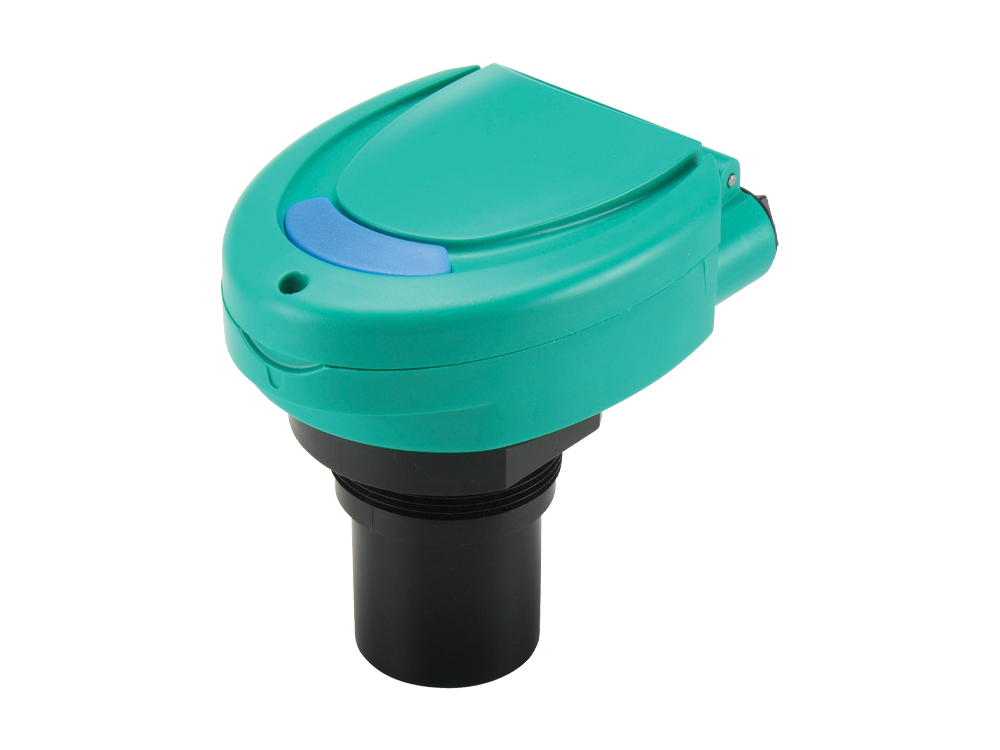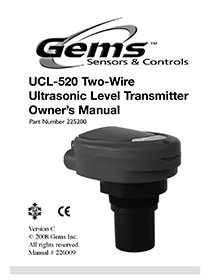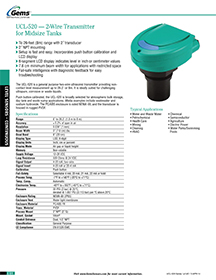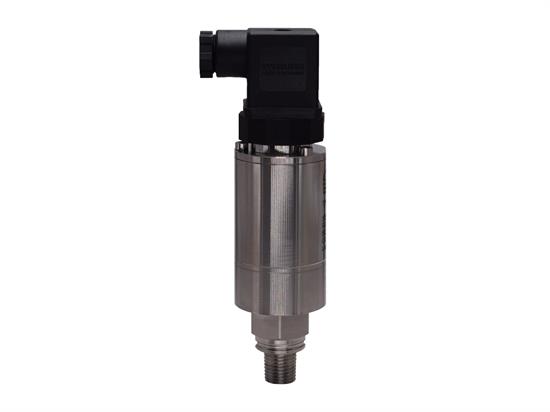Can I use the transmitter in a standpipe application?
Yes. They can be mounted in a standpipe to filter out turbulence and surface foam. The pipe could have diameters of between 1" and 6".
What is Relay output?
A Relay output is a small mechanical dry contact switch. The sensors internal circuit tells the relay to energize or de-energize when a change to the input has occurred. The relay can be wired either normally open or normally closed by reversing the polarity of the circuit.
What is the difference between the Relay and the FET?
The Relay is a mechanical switch. A tiny arm moves inside the relay providing either an open or closed contact. A FET switch (Field Effect Transistor) is a solid state switch, no moving parts. The FET switch is designed for interfacing to a PLC. The maximum rating for the FET is 36 VDC at 100mA. The Relay is designed for interfacing directly to a device such as a light buzzer or another relay. The maximum rating for the Relay is 60 VDC/VAC at 1A.
What is the difference between the three wire and two wire UCL-200 series units?
The UCL-200 series three-wire ultrasonic transmitters have a greater measurement span (24.5' & 40') than the two-wire ultrasonic units (18").
What size cable should I use to wire a two wire level transmitter back to a relay controller?
Generally, 18-gauge cable should be sufficient for distances of up to 1000 feet. Shielded cable is recommended, especially in areas with high amounts of electrical noise. The entire loop resistance should not exceed 900 ohms.
After programming my Ultrasonic Sensor, the output constantly reads 4mA, what should I do?
Recalibrate the sensor. The sensor reads to the 1/10 of an inch and the decimal point is easy to miss. It is possible to calibrate the unit to one distance and actually be at another distance. Example: 123" is 12.3" and NOT 123". If EC4 is entered as 100 and EC20 at 25, the sensor assumes the range to be from 10.0" to 2.5". Any distance over 10.0" would then read 4mA.
No signal is being measured from the ULC-200 sensor?
Part Number 201002 and 201003: The current outputs for these sourcing transmitters reference negative. Example: All input channels on a PLC are connected to the negative side of the power supply. These sensors require a 14-36 VDC, 200mA power supply. To test your sensor, place a multimeter set for mA in place of the PLC. Part Number 201001: The current output for this loop powered transmitter is contained within the two-wire connection. The sensor only consumes between 4 and 20 mA at all times. This sensor requires an 18-36 VDC, 25 mA power supply. To test this sensor, place a multimeter set for mA in place of the PLC. Always check which model of UCL-200 series transmitter you have. They all appear the same but each has a subtle difference between their wiring. With the source models make sure the power supply is rated between 14 and 36 VDC and at least 200 mA per transmitter. With multiple units, add 200 mA for every unit. Example: 4 transmitters require a minimum of 800 mA of power.
The display flickers or is blank, but the output is locked. Why?
When the acoustic response is lost, "LOST" should be seen on the display. Sometimes after many minutes, a flickering display is seen instead. Assume a "LOST" signal and reposition the transmitter or recycle power to reset the device.
Why isn't the transmitter receiving a valid return signal?
Please check the following:
Beam cone interference such as the sidewall, ladders, seams, rungs or pipes within the beam cone.
Proper installation - check that the transmitter is installed level and free from interference from the installation fitting or flange.
Sufficient power being supplied to the transmitter.
Existence of bubbles or foam and/or agitation/turbulence in the process medium.
What if the output reading is different from the actual reading?
Check for a calibration error, or process variables in the tank interfering with sound waves. Power down the sensor to factory reset and recalibrate the sensor. If necessary, evaluate transmitter installation and application.
Why is the green LED flashing on the UCL-210?
A flashing LED indicates the transmitter has no signal return strength and the device has gone into a fail-safe condition. During the fail-safe condition the UCL-210 will provide a current output of 22mA. Once the signal is again detected the LED will turn back ON continuously and the current will indicate the appropriate measured value.
Why is there a reading of LOST on the display?
A reading of "LOST" in the display indicates the transmitter is not receiving a valid return signal. Check for the following scenarios and try these suggestions:
Interference from objects within the beam path such as the sidewall of a tank, ladders, seams, rungs or pipes; as well as interference from the installations fitting. Remove the sensor from the tank and test it by either bouncing the signal off a flat surface or off the liquid through a man way. If the unit reads the distance correctly, move the sensor in the tank to an area free from interference.
Bottom of the sensor is not installed into the tank completely. Example: Installing the sensor in a 2" flanged standpipe that is 12" tall. The bottom of the transmitter would be over 10" hidden inside of the flange. Getting the return echoes into that standpipe would be difficult. Shorten the standpipe so that the sensor is intruding into the tank.
Signals out of range: The level is farther from the sensor than its range or the level has exceeded the TANK/MAXR value. For the UCL-200 series: program the sensor to reflect what you wish to see when the level falls outside the range of the sensor. For the UCL-210 series: wait until the level is within the range of the sensor.
Absorption of sound wave either by foam or turbulence: Is there any foam, bubbles or turbulence in the application? These can absorb the ultrasonic signal and prevent enough of it from being returned to the sensor. If foam is present, installing the sensor within a pipe may be a solution. But remember, adding a pipe eliminates the non-contacting benefits and coating issues need to be addressed.
Is sufficient input power being supplied to the sensor? The ULC-200 requires 14-36 VDC, the UCL-20 requires 14-36 VDC and the UCL-210 requires 12-36 VDC. Check your power supply. This typically occurs when multiple units are connected through a single power supply.
The display in Centimeter Mode is not accurate to the actual measurement. In the CM mode, the display value is rounded and some tenth numbers will not be seen.
The display shows a value that makes no sense. Check the ALIN mode. Is it in the ON position? If left in the ON position, a value will be shown on the display that represents the strength of the signal in decibels. When in the ON position, the 4-20mA-signal output is blocked. Check to see if the ALIN mode is OFF for normal operations.
The ALIN feature is ON but the value has decreased. The ALIN mode is only for one height when it was activated. If the level has moved, the mode must be reactivated for a correct reading. ALIN is a spot measurement for only one point in time and one height.
.tmb-desktopfp.png?Status=Master&sfvrsn=a3f21214_5)
 SEARCH OUR RESOURCE CENTER
SEARCH OUR RESOURCE CENTER







